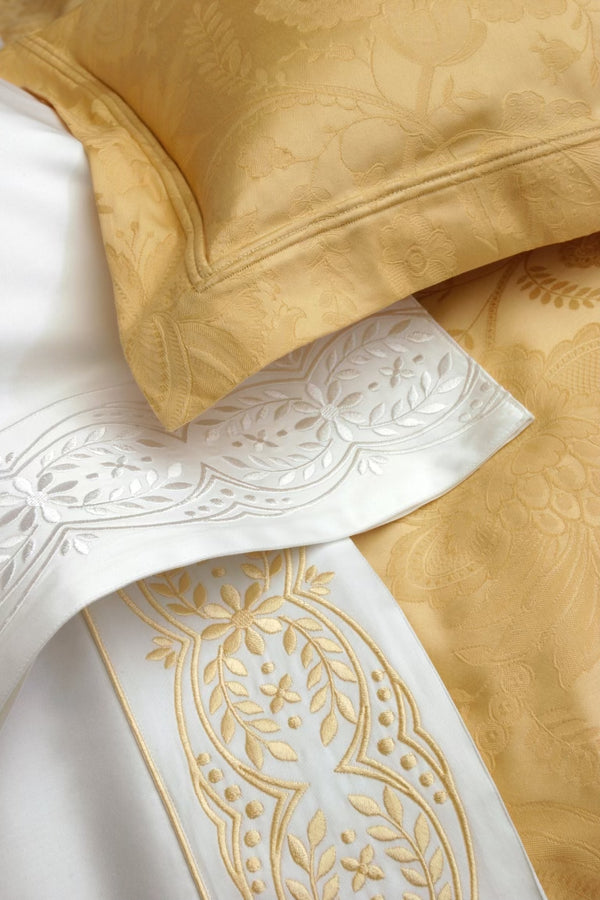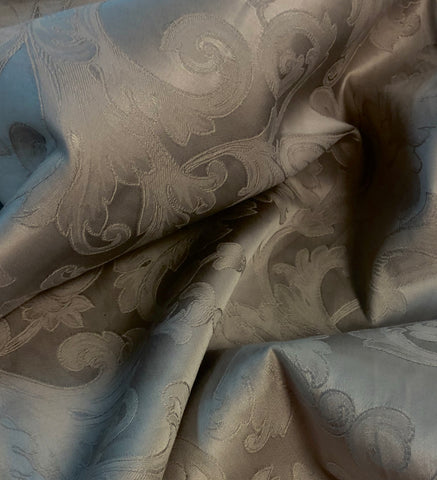Sewing & Thread Counts

Sewing & Thread Count: The Details of True Luxury
At Kearsley, true luxury is found in the details—where every stitch is placed with precision and every thread count is chosen with intention. Our expert sewing techniques reinforce durability while delivering a refined finish that enhances the beauty and integrity of each piece.
Thread count is never used as a marketing gimmick—it’s selected based on fiber quality, weave type, and end use. From the tailored crispness of our percale to the smooth, luminous hand of our sateen, each fabric is engineered to balance breathability, softness, and longevity.
Every element is crafted to deliver lasting comfort and timeless elegance—because true luxury is not just how it looks, but how it lives with you over time.
The Art of Sewing: Strength, Beauty & Lasting Quality
Exceptional sewing is one of the most labor-intensive—and essential—elements of crafting fine linens. While beautiful fabric forms the foundation, it’s the precision of stitching and finishing that transforms linens into enduring works of art.
Tiny Stitches, Stronger Seams
Smaller, tighter stitches take more time to execute but result in significantly stronger, longer-lasting seams. These fine stitches resist unraveling and create a clean, refined finish—adding elegance while reinforcing durability with every thread.
French Seams
A couture-level detail, French seams are sewn twice—first inside-out, then right-side-out—encasing raw fabric edges entirely. This technique not only looks beautiful, but also enhances the strength and longevity of the seam, making it ideal for delicate fabrics and luxury bedding.
Full Doubled Hems
A true hallmark of quality, full doubled hems are made by folding the fabric twice before sewing. Found on side and bottom edges, they prevent fraying and preserve the structure and finish of the piece over time.
Exceptional sewing is one of the most labor-intensive—and essential—elements of crafting fine linens. While beautiful fabric forms the foundation, it’s the precision of stitching and finishing that transforms linens into enduring works of art.
Tiny Stitches, Stronger Seams
Smaller, tighter stitches take more time to execute but result in significantly stronger, longer-lasting seams. These fine stitches resist unraveling and create a clean, refined finish—adding elegance while reinforcing durability with every thread.
French Seams
A couture-level detail, French seams are sewn twice—first inside-out, then right-side-out—encasing raw fabric edges entirely. This technique not only looks beautiful, but also enhances the strength and longevity of the seam, making it ideal for delicate fabrics and luxury bedding.
Full Doubled Hems
A true hallmark of quality, full doubled hems are made by folding the fabric twice before sewing. Found on side and bottom edges, they prevent fraying and preserve the structure and finish of the piece over time.

Thread Count: Understanding Quality Beyond the Numbers
Thread count refers to the number of threads woven into one square inch of fabric, combining both horizontal (weft) and vertical (warp) threads. While often associated with luxury, thread count alone does not determine quality—the type of fiber, weaving technique, and overall craftsmanship play an equally important role in the feel and performance of fine linens.
The Truth About Thread Count
Higher thread count can mean finer, more densely woven fabric, offering a smoother, more refined hand. However, beyond a certain point, it’s the quality of the fibers—not just the count—that matters most.
Some manufacturers falsely inflate thread counts by using multi-ply, lower-quality yarns, resulting in bedding that feels stifling and lacks breathability.
The finest linens balance thread count with fiber quality, ensuring a luxurious feel, durability, and optimal airflow for a truly restful sleep.
Kearsley’s Approach to Thread Count
Because Kearsley uses only the finest extra-long-staple fibers, thread count is a matter of personal preference rather than a measure of quality. You can select based on the warmth, texture, and hand feel that suit you best.
We invite you to experience the difference—cutting samples are available upon request and complimentary for registered Interior Design Trade professionals.
Photo: Soleil Sateen with Double Satin Stitch
Thread count refers to the number of threads woven into one square inch of fabric, combining both horizontal (weft) and vertical (warp) threads. While often associated with luxury, thread count alone does not determine quality—the type of fiber, weaving technique, and overall craftsmanship play an equally important role in the feel and performance of fine linens.
The Truth About Thread Count
Higher thread count can mean finer, more densely woven fabric, offering a smoother, more refined hand. However, beyond a certain point, it’s the quality of the fibers—not just the count—that matters most.
Some manufacturers falsely inflate thread counts by using multi-ply, lower-quality yarns, resulting in bedding that feels stifling and lacks breathability.
The finest linens balance thread count with fiber quality, ensuring a luxurious feel, durability, and optimal airflow for a truly restful sleep.
Kearsley’s Approach to Thread Count
Because Kearsley uses only the finest extra-long-staple fibers, thread count is a matter of personal preference rather than a measure of quality. You can select based on the warmth, texture, and hand feel that suit you best.
We invite you to experience the difference—cutting samples are available upon request and complimentary for registered Interior Design Trade professionals.
Photo: Soleil Sateen with Double Satin Stitch

The Art & Science of Fabric Processing
The journey from raw fiber to finished fabric is shaped by a combination of traditional craftsmanship and advanced techniques. From mercerization for added luster to the art of fiber dyeing, every step impacts the softness, durability, and beauty of the final textile.
Mercerization: Enhancing Softness & Sheen
Mercerization is a process used to soften cotton fibers and enhance their luster. The fabric is treated with sodium hydroxide (lye), then neutralized in an acid bath while held under tension. This technique:
Creates a silky sheen, especially in sateen fabrics.
Improves dye absorption, resulting in rich, long-lasting colors.
Strengthens the fibers for greater durability and resistance to shrinkage.
Fabric Processing Varies by Country & Mill
Not all fabric processing is equal. Lower-quality fibers are often coated with chemicals to simulate a soft feel, which washes away over time. At Kearsley, we prioritize authentic softness and quality, ensuring that our fabrics feel as luxurious as they look.
Eco-Friendly Processing & Certifications
Italy leads in environmentally responsible fabric processing, following rigorous standards such as:
OEKO-TEX® Standard 100 – Ensures textiles are free from harmful substances, making them safe for people and the environment.
Global Organic Textile Standard (GOTS) – A certification guaranteeing that fabrics meet organic and sustainable production criteria.
The Art of Fiber Dyeing:
Dyeing fabric is both a science and an art, requiring a deep understanding of natural fibers, temperature, and barometric pressure. In Italy, becoming a master dyer requires a 20-year apprenticeship, ensuring that colors remain vibrant, non-bleeding, and fade-resistant.
Darker dyes can affect fabric texture, often making textiles feel denser.
For the most accurate experience, it’s best to feel a sample in your chosen color.
Certain shades—especially reds, purples, and blacks—are more complex to produce, making them more costly.
Every step in fabric processing, from fiber selection to dyeing, plays a role in creating luxurious, long-lasting linens that feel as good as they look.
The journey from raw fiber to finished fabric is shaped by a combination of traditional craftsmanship and advanced techniques. From mercerization for added luster to the art of fiber dyeing, every step impacts the softness, durability, and beauty of the final textile.
Mercerization: Enhancing Softness & Sheen
Mercerization is a process used to soften cotton fibers and enhance their luster. The fabric is treated with sodium hydroxide (lye), then neutralized in an acid bath while held under tension. This technique:
Creates a silky sheen, especially in sateen fabrics.
Improves dye absorption, resulting in rich, long-lasting colors.
Strengthens the fibers for greater durability and resistance to shrinkage.
Fabric Processing Varies by Country & Mill
Not all fabric processing is equal. Lower-quality fibers are often coated with chemicals to simulate a soft feel, which washes away over time. At Kearsley, we prioritize authentic softness and quality, ensuring that our fabrics feel as luxurious as they look.
Eco-Friendly Processing & Certifications
Italy leads in environmentally responsible fabric processing, following rigorous standards such as:
OEKO-TEX® Standard 100 – Ensures textiles are free from harmful substances, making them safe for people and the environment.
Global Organic Textile Standard (GOTS) – A certification guaranteeing that fabrics meet organic and sustainable production criteria.
The Art of Fiber Dyeing:
Dyeing fabric is both a science and an art, requiring a deep understanding of natural fibers, temperature, and barometric pressure. In Italy, becoming a master dyer requires a 20-year apprenticeship, ensuring that colors remain vibrant, non-bleeding, and fade-resistant.
Darker dyes can affect fabric texture, often making textiles feel denser.
For the most accurate experience, it’s best to feel a sample in your chosen color.
Certain shades—especially reds, purples, and blacks—are more complex to produce, making them more costly.
Every step in fabric processing, from fiber selection to dyeing, plays a role in creating luxurious, long-lasting linens that feel as good as they look.

Understanding Fiber Quality: Not All Cotton is Created Equal
The quality of cotton varies dramatically, even within the Egyptian cotton category, which includes 38 different grades. Much like wine varietals such as Chardonnay or Cabernet Sauvignon, different cotton types may share the same name but differ significantly in characteristics and quality.
The Gold Standard: Giza 87
Giza 87 is widely regarded as the finest cotton in the world, cultivated in the fertile Nile River Valley where ideal soil and climate conditions create an exceptionally long-staple fiber. This superior cotton is:
Incredibly strong, smooth, and durable, woven into fine, long-lasting fabrics.
Soft and breathable, providing a luxurious hand-feel that improves with each wash.
Spun into ultra-fine, strong threads, allowing for high thread count fabrics that remain both lightweight and durable.
The Truth About Cotton Processing & Labeling
Not all cotton labeled as Egyptian or high-quality lives up to its name. The origin and processing of cotton are just as important as the fiber itself.
Inferior cotton can include swept-up dust and short fibers glued together with chemicals, technically qualifying as "cotton" but resulting in poor-quality, synthetic-feeling fabric.
Truth in labeling is often misleading—many manufacturers inflate quality claims or manipulate thread counts to give the illusion of luxury.
Thread Count & Fiber Quality: More Than Just Numbers
Thread count measures the number of threads per square inch of fabric, with higher counts often associated with luxury. However, thread count alone does not define quality—the type of fiber and weaving process are equally important.
High thread count with low-quality fibers can create dense, stifling fabrics that lack breathability.
True luxury linens balance thread count with fiber quality, ensuring softness, durability, and airflow for a restful sleep.
Reputable brands prioritize transparency, offering authentic fiber content and expert craftsmanship over misleading marketing tactics.
At Kearsley, we use only the finest extra-long-staple fibers, allowing you to select thread count based on the warmth, texture, and hand-feel you prefer—rather than as a measure of quality alone.
Cutting samples are available for comparison and complimentary to registered Interior Design Trade
professionals.
Photo: Essentials Sateen with Triple Sating Stitch
The quality of cotton varies dramatically, even within the Egyptian cotton category, which includes 38 different grades. Much like wine varietals such as Chardonnay or Cabernet Sauvignon, different cotton types may share the same name but differ significantly in characteristics and quality.
The Gold Standard: Giza 87
Giza 87 is widely regarded as the finest cotton in the world, cultivated in the fertile Nile River Valley where ideal soil and climate conditions create an exceptionally long-staple fiber. This superior cotton is:
Incredibly strong, smooth, and durable, woven into fine, long-lasting fabrics.
Soft and breathable, providing a luxurious hand-feel that improves with each wash.
Spun into ultra-fine, strong threads, allowing for high thread count fabrics that remain both lightweight and durable.
The Truth About Cotton Processing & Labeling
Not all cotton labeled as Egyptian or high-quality lives up to its name. The origin and processing of cotton are just as important as the fiber itself.
Inferior cotton can include swept-up dust and short fibers glued together with chemicals, technically qualifying as "cotton" but resulting in poor-quality, synthetic-feeling fabric.
Truth in labeling is often misleading—many manufacturers inflate quality claims or manipulate thread counts to give the illusion of luxury.
Thread Count & Fiber Quality: More Than Just Numbers
Thread count measures the number of threads per square inch of fabric, with higher counts often associated with luxury. However, thread count alone does not define quality—the type of fiber and weaving process are equally important.
High thread count with low-quality fibers can create dense, stifling fabrics that lack breathability.
True luxury linens balance thread count with fiber quality, ensuring softness, durability, and airflow for a restful sleep.
Reputable brands prioritize transparency, offering authentic fiber content and expert craftsmanship over misleading marketing tactics.
At Kearsley, we use only the finest extra-long-staple fibers, allowing you to select thread count based on the warmth, texture, and hand-feel you prefer—rather than as a measure of quality alone.
Cutting samples are available for comparison and complimentary to registered Interior Design Trade
professionals.
Photo: Essentials Sateen with Triple Sating Stitch



